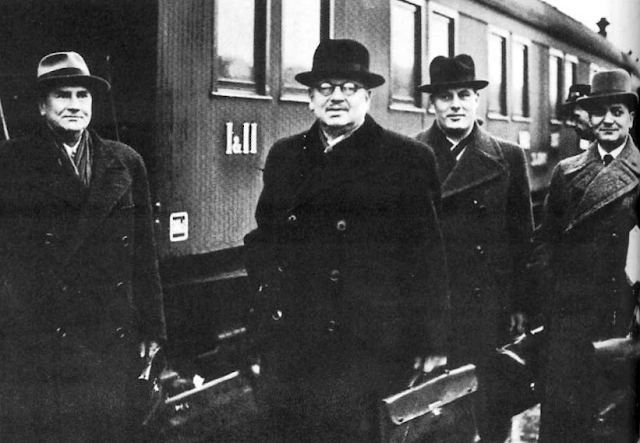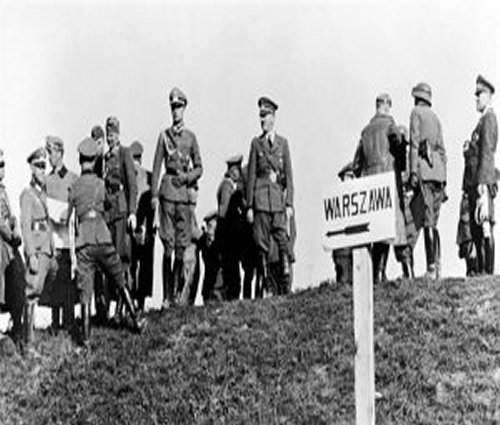Monday 16 October 1939
Western Front: The Wehrmacht sends troops into the Saar area that the French had occupied during Operation Saar. Attacking in the morning on a four-mile front east of the Moselle, they are finally halted by French gunfire. In the afternoon, they attack along a 20-mile front east of the Saar River. The offensives clear the area of French observers, the main French force having long ago withdrawn back to France, behind the safety of the Maginot Line.
European Air Operations: The first Luftwaffe strategic bombing attack is launched on Great Britain in the afternoon. Nine Junkers Ju 88 bombers from Gruppe 1 of Kampfgeschwader (KG) 30 (Helmut Pohle) and a few Heinkel 111s attack Rosyth, Firth of Forth. The cruiser HMS Southampton and HMS Edinburgh are lightly damaged. Some casualties are suffered on the destroyer HMS Mohawk. Three German planes (two Junkers and a Heinkel) are lost when some Spitfires of the Glasgow and Edinburgh Auxillary Air Force Squadrons (602 and 603) intervene.
These reportedly are the first enemy aircraft downed over the UK to actually fall on the UK, though one or two previously had been shot down but fallen nearby. There are a lot of "firsts" in World War II - first shot down by the RAF, first shot down from the UK, first shot down to fall on the UK, first shot down over England... and so on and so forth. To be clear, the first aircraft shot down by a UK-based RAF aircraft was a Dornier 18 over the North Sea on 8 October.
RAF bombers drop leaflets over Germany during the previous night. The British are learning from feedback: Germans are afraid to be seen stooping to pick up the literature, so the British propaganda office makes the typescript big enough to read from a standing position.
Battle of the Atlantic: The Kriegsmarine revises its instructions to U-boat commanders:
All merchant ships definitely recognized as enemy ones (British and French) can be torpedoed without warning. Passenger steamers in convoy can be torpedoed a short while after notice has been given of the intention to do so.In practice, it is virtually impossible to give warning to ships sailing in convoys, and it is seldom done except inadvertently.
German tanker Emmy Friedrich leaves Tampico, Mexico for a rendezvous with Admiral Graf Spee. Neutrality patrols are on the lookout for it.
The British detain US freighter Gateway City and release US freighter Black Heron.
German vessel Halle is scuttled to avoid capture west of Dakar.
U-35 appears on the cover of Life Magazine for its rescue of Greek sailors in the Diamantis incident.
Finland: The Finnish negotiators return from Moscow.
Poland: The Germans expel all Poles from Gdynia.
Iraq: The Grand Mufti arrives in Baghdad following his escape from the French.
 |
| Finnish negotiator Juho Kusti Paasikivi returning from Moscow on 16 October 1939 (Jukka Nevakivi: Apu jota ei annettu, ISBN 951-0-24676-x, page 213 photo 9). |
October 1939
October 1, 1939: Occupation of WarsawOctober 2, 1939: Hel Peninsula Falls
October 3, 1939: The Diamantis Incident
October 4, 1939: Otto Kretschmer Gets Rolling
October 5, 1939: Polish Resistance Ends
October 6, 1939: Hitler Peace Effort
October 7, 1939: The British Have Arrived
October 8, 1939: First RAF Kill from UK
October 9, 1939: "City of Flint" Incident
October 10, 1939: Lithuania Under Pressure
October 11, 1939: The Atomic Age Begins
October 12, 1939: England Rejects Hitler's Peace Offer
October 13, 1939: Charles Lindbergh Speaks Out
October 14 1939: Royal Oak Sunk
October 15, 1939: Cuban Rockets
October 16, 1939: First Aircraft Shot Down Over UK
October 17, 1939: Marshall Mannerheim Returns
October 18, 1939: Prien Receives His Award
October 19, 1939: Preliminary Plan for Fall Gelb
October 20, 1939: Hitler Grapples with the Jews
October 21, 1939: Hurricanes to the Rescue!
October 22, 1939: Goebbels Lies Through His Teeth
October 23, 1939: Norway the Center of Attention
October 24, 1939: German "Justice" Gets Rolling
October 25, 1939: Handley Page Halifax Bomber First Flies
October 26, 1939: Jozef Tiso Takes Slovakia
October 27, 1939: King Leopold Stands Firm
October 28, 1939 - First Luftwaffe Raid on Great Britain
October 29, 1939: Tinkering with Fall Gelb
October 30, 1939: Defective Torpedoes
October 31, 1939: Molotov Issues an Ultimatum
2019

















